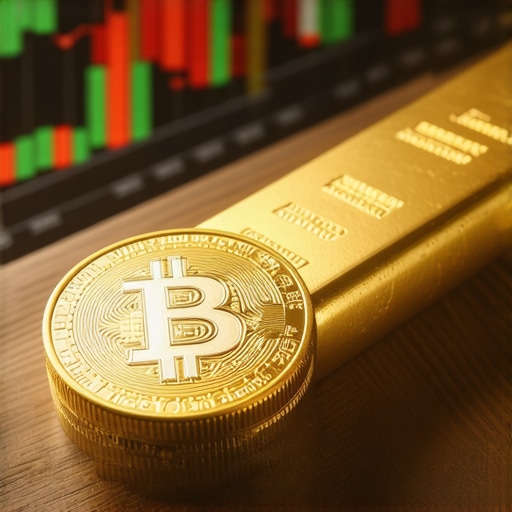Understanding Gold Investments: A Comprehensive Overview
As the gold market evolves, investors are increasingly looking to explore various types of gold investments for 2025. With economic uncertainty and inflation concerns on the rise, gold remains a popular choice for safeguarding wealth. In this article, we will delve into the different avenues for investing in gold, highlighting key trends and strategies that can enhance your financial portfolio.
Physical Gold: Coins, Bars, and Bullion
One of the most traditional forms of investing in gold is through physical assets such as gold coins, bars, and bullion. Collecting gold bullion can be a tangible way to own gold, providing both aesthetic pleasure and potential financial returns. Investors often prefer coins due to their minting and historical value, making them a dual investment option.
When considering physical gold, it’s important to assess the costs involved, including storage and insurance. Many investors choose to keep their gold in a safe or a secure vault to protect against theft or loss. For those interested in retirement planning, gold IRAs offer a way to incorporate physical gold within a retirement account, adding a layer of security and potential growth.
Gold ETFs: A Flexible Investment Option
Exchange-Traded Funds (ETFs) have gained popularity as a flexible investment option in the gold market. Gold ETFs allow investors to buy shares that represent ownership in gold without the need to physically hold the metal. This can be a more convenient option for those who prefer to manage investments digitally. In 2025, we expect to see further innovations in gold ETFs, making them accessible to a broader audience.
Investing in gold ETFs can provide exposure to gold price movements while offering liquidity and ease of trading. Furthermore, they often come with lower expense ratios compared to traditional mutual funds, making them an attractive choice for cost-conscious investors.
Gold Mining Stocks: A Potentially Profitable Alternative
Another avenue for investing in gold is through mining stocks. Gold mining companies can offer investors leveraged exposure to gold prices, as their stock prices may rise significantly when gold prices increase. However, it’s essential to conduct thorough research on the mining companies you consider investing in. Factors such as management expertise, production costs, and geopolitical risks can impact a mining company’s profitability.
For those looking for diversification, gold mutual funds can provide exposure to various mining companies and reduce the risks associated with investing in individual stocks. By spreading investments across multiple companies, investors can minimize the impact of any single company’s underperformance.
Conclusion: Choosing the Right Gold Investment Strategy for 2025
As you consider your investment options for 2025, it’s crucial to evaluate which type of gold investment aligns with your financial goals and risk tolerance. Whether you choose physical gold, gold ETFs, or mining stocks, understanding the market trends and strategies will empower you to make informed decisions. For more insights on maximizing your gold investment returns, check out our comprehensive guides on investment strategies and gold price forecasts. Investing in gold is not just about wealth preservation; it’s about making strategic choices that can lead to long-term financial success.
Strategies for Investing in Gold: Enhancing Your Portfolio
As gold continues to be a valuable asset in uncertain economic times, exploring effective strategies for investing in gold in 2025 is essential. By understanding market dynamics, investors can maximize their returns and align their portfolios with their financial objectives. In this section, we will discuss various strategies that can help you navigate the complexities of the gold market.
Diversifying Gold Investments: A Balanced Approach
Diversification is a fundamental investment principle that applies to gold as well. By spreading your investments across different types of gold assets, such as gold stocks, ETFs, and physical gold, you can reduce risk and improve your chances of achieving consistent returns. This balanced approach allows you to benefit from different market conditions, whether gold prices are rising or falling.
Understanding Gold Market Trends: Key Indicators
To make informed investment choices, it’s vital to stay updated on gold market trends and key indicators that influence prices. Factors such as global demand, geopolitical events, and inflation rates can significantly affect gold prices. For instance, as central banks adjust their monetary policies, it can lead to fluctuations in gold value. By analyzing these trends, you can better time your investments and optimize your portfolio. For more insights into market dynamics, explore our guide on understanding gold prices.
Gold IRAs: A Strategic Retirement Investment
For investors looking to incorporate gold into their retirement planning, Gold IRAs can be an excellent choice. These specialized retirement accounts allow individuals to hold physical gold and other precious metals, providing a hedge against inflation and market volatility. By understanding the rules and regulations surrounding Gold IRAs, investors can enhance their retirement savings while capitalizing on the unique benefits of gold.
Utilizing Gold Price Forecasts: Making Informed Decisions
When investing in gold, utilizing gold price forecasts can guide your investment decisions. Analysts provide forecasts based on various economic indicators and market trends. By incorporating this information into your strategy, you can make more calculated decisions about when to buy or sell gold. For detailed insights, check out our gold price forecast for 2025.
Investing in Gold Mining Stocks: Risks and Rewards
Investing in gold mining stocks offers a different risk-reward profile compared to owning physical gold. While mining companies can provide leveraged exposure to gold prices, they also come with operational risks and market volatility. Investors should conduct thorough research and consider factors such as a company’s production costs, management quality, and market position before investing in mining stocks.
Conclusion: Crafting a Gold Investment Strategy for 2025
As you plan your gold investment strategy for 2025, remember that a well-rounded approach, combined with careful market analysis, can lead to successful outcomes. Whether you choose to invest in physical gold, ETFs, or mining stocks, understanding the intricacies of each option will empower you to make informed decisions. For further insights on crafting your strategy, explore our articles on top investment tips and current demand trends. By staying informed and strategic, you can enhance your investment portfolio and achieve your financial goals in the gold market.
Advanced Strategies for Maximizing Your Gold Investments
As the landscape of gold investing evolves, adopting advanced strategies becomes essential for maximizing your portfolio’s potential in 2025. This section delves into specific tactics that experienced investors can leverage to enhance their returns and better navigate the complexities of the gold market.
Understanding Gold Trading Techniques: A Deeper Dive
To capitalize on price fluctuations, understanding effective gold trading techniques is vital. Techniques such as day trading, swing trading, and position trading can cater to different investment styles and risk appetites. Day trading involves making quick trades to exploit short-term price movements, while swing trading focuses on capturing price gains over several days or weeks. For those looking to invest for the long term, position trading offers a strategy that relies on holding positions for extended periods based on fundamental analysis. Each method has its advantages and risks, so it’s important to select the one that aligns with your investment goals.
Gold Versus Other Assets: Comparative Analysis
Conducting a comparative analysis of gold against other asset classes like stocks and real estate can provide valuable insights into your overall investment strategy. While stocks may offer higher returns during economic booms, gold tends to perform well during economic downturns, making it an excellent hedge against inflation and a market crash. Understanding these dynamics can help you allocate your assets more effectively, ensuring your portfolio remains resilient regardless of market conditions.
Evaluating Gold ETFs: Key Considerations
When considering gold exchange-traded funds (ETFs) as part of your investment strategy, it’s essential to evaluate their structure, fees, and performance. Gold ETFs allow investors to gain exposure to gold without the need to hold physical gold, making them a convenient option. However, not all ETFs are created equal. Factors such as tracking error, management fees, and liquidity can significantly impact your investment returns. For an in-depth look at the advantages and disadvantages of gold ETFs, check out our article on exploring gold ETFs.
Gold Mutual Funds: Diversifying Your Gold Exposure
Investing in gold mutual funds can be an excellent way to diversify your exposure to gold while benefiting from professional management. These funds invest in a portfolio of gold-related assets, including mining stocks and ETFs, allowing for broader diversification. When selecting a gold mutual fund, consider factors such as the fund’s past performance, expense ratio, and the expertise of the fund manager. This approach can help mitigate risks associated with individual stock picking while still capturing the potential upside of the gold market.
Monitoring Global Economic Factors: Staying Ahead of the Curve
Continuous monitoring of global economic factors is crucial for successful gold investment. Events such as changes in interest rates, inflation data, and geopolitical tensions can significantly influence gold prices. Staying informed about these factors will enable you to make timely investment decisions. For a comprehensive analysis of how economic changes shape gold demand patterns, explore our article on how economic changes affect gold demand.
Conclusion: Implementing Strategies for Success
Implementing advanced strategies for gold investment can significantly enhance your financial outcomes in 2025. By understanding trading techniques, evaluating gold ETFs and mutual funds, and monitoring global economic factors, you can position yourself to take advantage of market opportunities. For more in-depth strategies, consider reading our guide on investing in gold. As you refine your approach, remember that a disciplined investment strategy and continual market analysis are key to success in the gold market.
Understanding Gold Price Fluctuations: A Comprehensive Overview
Gold prices can be highly volatile, influenced by a myriad of factors ranging from economic indicators to geopolitical events. For investors looking to navigate the complexities of the gold market, understanding the key factors that drive these fluctuations is essential. In this section, we will explore the dynamics of gold pricing and provide insights into how these factors can impact your investment decisions.
Key Economic Indicators Affecting Gold Prices
Economic indicators play a crucial role in shaping gold prices. Factors such as inflation rates, interest rates, and currency strength can significantly influence the demand for gold. For instance, when inflation rises, many investors turn to gold as a hedge against the declining purchasing power of fiat currencies. Similarly, lower interest rates can make gold more attractive since the opportunity cost of holding gold, which does not yield interest, decreases. Understanding these economic indicators can help investors anticipate potential price movements.
Geopolitical Tensions and Their Impact on Gold Prices
Geopolitical tensions, including conflicts, wars, and political instability, can also lead to increased demand for gold. During uncertain times, investors often flock to safe-haven assets like gold to protect their wealth, driving prices higher. For a deeper understanding of how these tensions can influence gold demand, refer to our article on how economic changes shape gold demand. Monitoring global events and their implications for the gold market can provide valuable insights for making informed investment choices.
Supply Chain Dynamics in the Gold Market
The supply side of the gold market is equally important in understanding price fluctuations. Gold mining production levels, reserves, and mining costs can all affect the supply of gold in the market. Disruptions in mining operations due to natural disasters, regulatory changes, or labor strikes can lead to supply shortages, prompting price increases. Investors should stay informed about the state of gold mining and any potential disruptions that may affect supply. For more on this topic, consider reading our guide on understanding gold supply and demand in 2025.
Market Sentiment and Speculation
Market sentiment and speculative trading can also create volatility in gold prices. Investor psychology plays a significant role in price movements, as fear and greed can drive demand beyond fundamental factors. Traders often react to news events or technical indicators, leading to short-term price fluctuations. Keeping a close watch on market sentiment can help you gauge potential price movements and adjust your investment strategy accordingly.
Conclusion: The Importance of Staying Informed
Understanding gold price fluctuations is crucial for making informed investment decisions in the gold market. By keeping abreast of economic indicators, geopolitical events, supply dynamics, and market sentiment, you can better navigate the complexities of gold investing. Consider exploring our comprehensive guide on gold investment for additional strategies and insights. As you refine your approach, remember that a disciplined investment strategy and continual market analysis are key to success in the gold market.
Frequently Asked Questions About Gold Prices
What causes fluctuations in gold prices?
Gold prices fluctuate due to a variety of factors including economic indicators, geopolitical tensions, supply chain dynamics, and overall market sentiment. Changes in inflation rates, interest rates, and currency values can significantly influence gold demand and pricing.
How does inflation affect gold prices?
Inflation typically drives gold prices higher as investors seek to hedge against the declining purchasing power of fiat currencies. When inflation rises, gold becomes an attractive investment option, leading to increased demand and, consequently, higher prices.
What role do interest rates play in determining gold prices?
Interest rates have a direct impact on gold prices. Lower interest rates reduce the opportunity cost of holding gold, which does not yield interest, making it a more appealing investment. Conversely, higher interest rates can lead to a decline in gold demand.
How do geopolitical events influence gold prices?
Geopolitical events such as conflicts, wars, and political instability often lead to increased demand for gold as a safe-haven asset. During times of uncertainty, investors tend to flock to gold, driving prices upward.
What is the significance of gold supply dynamics?
Gold supply dynamics, including mining production levels, reserves, and operational costs, play a crucial role in determining gold prices. Disruptions in mining activities, whether due to natural disasters or regulatory changes, can lead to supply shortages and increased prices.
How does market sentiment affect gold prices?
Market sentiment is driven by investor psychology, which can lead to speculative trading. Fear and greed can cause prices to fluctuate beyond fundamental factors, making it essential for investors to monitor market sentiment to gauge potential price movements.
Where can I find reliable information on gold prices?
Reliable information on gold prices can be found through various financial news sites, investment platforms, and authoritative resources such as the World Gold Council and financial institutions that specialize in precious metals.
How can I invest in gold?
Investing in gold can be done through various means including purchasing physical gold, investing in gold ETFs, or trading gold futures. Each method has its pros and cons, so it’s important to research and understand which option aligns with your investment strategy.
What are some common misconceptions about gold investment?
Common misconceptions about gold investment include the belief that gold is a guaranteed way to make money, when in fact, it is subject to market volatility. Additionally, some investors may think that physical gold is the only way to invest, overlooking other options such as ETFs and mining stocks.
How should I stay informed about gold market trends?
To stay informed about gold market trends, regularly check financial news, subscribe to market analysis reports, and follow industry experts on social media. Engaging with trusted resources will help you make informed investment decisions.
Conclusion: Navigating the Gold Market
In summary, understanding the factors that influence gold prices is crucial for successful investing. By keeping informed about economic indicators, geopolitical developments, supply dynamics, and market sentiment, you can make educated decisions in the gold market. As you explore different investment avenues, remember that a disciplined approach and ongoing analysis are key to maximizing your returns in gold investing.










